

Originally posted January 9, 2016
Today's Gun of the Week is another Eastern Bloc (sort of) oddity, of an even odder variety than the CZ 82: a PHP MV9.
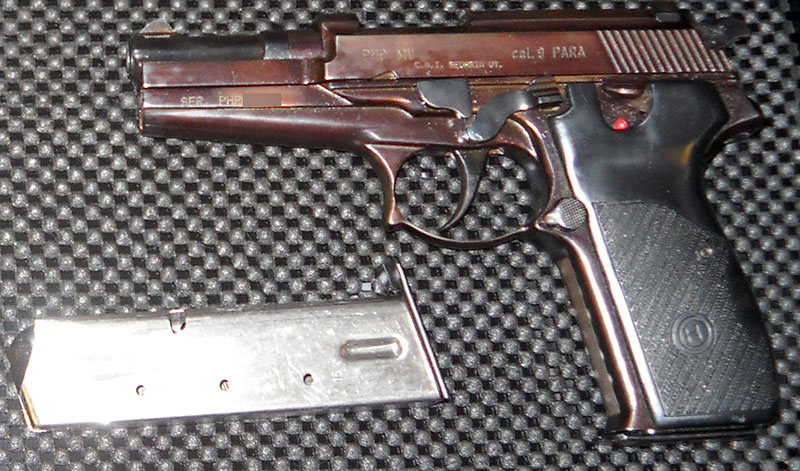
I took this photo with forced flash, so that the color would be more obvious. That's the first odd thing about this gun most people notice: it's browned. Browning is a finish that used to be fairly common on early firearms, but had pretty much gone out of fashion by the time the self-contained metallic cartridge became common (ca. 1860), and is virtually unseen in new-production guns today. It's a pretty primitive process.
Historical technology aside: One of the common problems with making guns, or pretty much anything else for that matter, out of steel is that steel, being mostly iron, rusts pretty readily. Various ways exist of making steel firearms corrosion-resistant, and, interestingly, one of the most typical involves corroding the surface of the weapon on purpose, in a controlled manner that, if done right, makes the surface resist ordinary rust. This is achieved by soaking the steel parts in various noxious chemical solutions which tend to be either acidic or caustic (both of which promote corrosion) and contain salts (ditto).
Today (and for quite a long time), the standard way of doing this is called bluing, because the resulting finish looks like it's a very dark blue. (It's actually black, but the layer isn't very thick, and so you get just enough of the steel's natural grey showing through that the eye sees a blue-black color.) The black coating is Fe3O4, more commonly known as magnetite or lodestone. There are a few different ways to get this result that we don't need to go into the details of here, but the most common industrial process used by gunmakers to do it in volume, and produce a high-quality finish, is called hot bluing because it involves a boiling caustic salt solution. This is not something you really want to be doing in your bathtub at home.
The brown coating you get from browning, on the other hand, is Fe2O3, common ferric oxide—rust. Steel doesn't need much encouragement to form a layer of this on the outside; the earliest firearms to be browned probably got that way without human intervention. The trick is getting it to stop rusting before it starts to lose structural integrity, which involves cutting it off from any further interaction with oxygen. Oil is usually the way this is done, although looking at my PHP, I suspect it may have been varnished.
Nowadays, bluing is still popular because it's traditional and it looks nice, but there are also other, more sophisticated ways of protecting firearms from corrosion. We saw in the CZ 82 entry that the steel parts can be enamel painted, though this has evident durability issues. Phosphor coatings, which tend to be more robust than bluing but also rather ugly, are common. Manufacturers also frequently offer versions in which the metal parts are simply made from an alloy that doesn't corrode readily (usually some form of stainless steel) and don't require a finish at all, and of course the polymer parts of hybrid guns like Glock pistols and their various imitators aren't going to rust because they're plastic. Plating steel guns in corrosion-resistant metals like nickel used to be quite common, but has largely gone out of style today because it's expensive and the coating wears off (as such metals tend to be fairly soft in comparison to steel).
All that said, I don't know for certain why the PHP is browned instead of blued, but I can make an educated guess, and it has to do with the gun's origins, which are spelled out in its name. "PHP" stands for Prvi Hravatski Pistolj, which means "First Croatian Pistol", and the gun is literally that.
See, in 1991, Croatia had a problem. Actually Croatia had more than two problems, because it had just launched a war of independence in a bid to get out of Yugoslavia.
Yugoslavia was an odd animal politically, a sort of side effect of both World Wars—after World War I, it was formed out of various Slavic remnants of the Austro-Hungarian Empire and Austria-Hungary's old enemy Serbia, and after World War II it shared most of eastern Europe's fate in that it became a Communist state. That Communist control gave it a sort of stability through the Cold War (when, owing mostly to the force of personality of its dictator, Marshal Tito, it remained successfully aloof from the Warsaw Pact and largely out of the conflict), but when European Communism ceased to be a going concern circa 1990, its old tensions soon pulled it apart.
Serbia had long been the most equal of all the equal animals that made up the Socialist Federal Republic of Yugoslavia—its capital, Belgrade, was Yugoslavia's capital—and Croatia, one of the aforementioned Austro-Hungarian remnants and thus historically no friend of Serbia, wanted out of what it perceived as an increasingly Serbia-dominated Yugoslav system. Serbia was... disinclined to let this happen.
And here we come to Croatia's problem: Serbia was also where almost all of Yugoslavia's industry was. In order to arm itself for an independence bid, it was going to have to get creative, because the established arms factories were all in Serbia—and it was going to have to be fast creativity. Now, as the old saying goes, good, cheap, and fast: pick any two, and the Croats didn't have a lot of money kicking around either.
The result was the PHP, an improvised sidearm for an improvised army fighting an improvised war to get out of what had originally been an improvised country. It's chambered in 9mm Parabellum, because 9mm Parabellum cartridges are about as abundant as nitrogen molecules in most of Europe; its design is mostly copied from the Walther P38 with a few details cribbed from the Beretta Model 92 (one version of which is used as the standard US military sidearm, the M9 pistol); and it's browned, I suspect because to hot blue guns in mass production you need huge tanks of boiling toxic chemicals, whereas for browning all you really need is slightly acidic water. It can be and has been done with pee, though I assume the Croats didn't actually do it that way.
As you might expect with a background like that, the PHP is not terribly well-regarded for the originality of its design (there basically is none) or the quality of its manufacture (which is charitably described as inconsistent).
Let's take a closer look at this particular one. Here it is with the action locked open (that thing in the background is the magazine, which I've propped it up on for a slightly better camera angle).
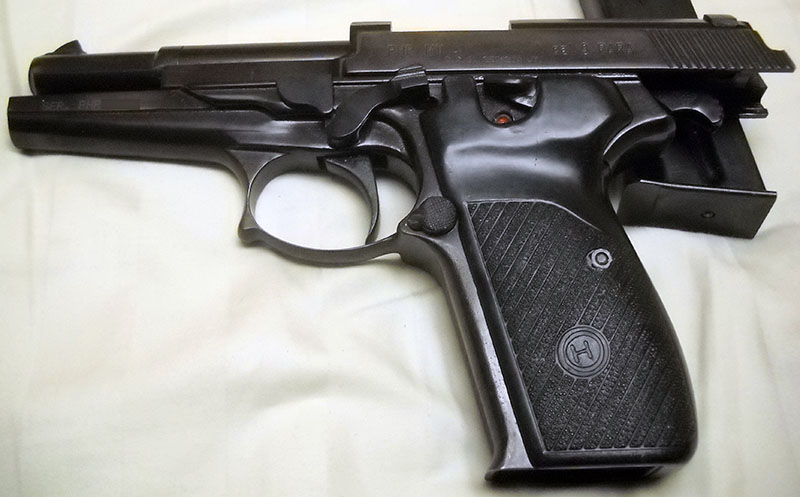
The PHP has a single/double-action trigger, like the CZ 82, and indeed like both of the guns it's a sort of hybrid copy of; unlike the CZ 82, it's supposed to have a decocker. Setting the safety (that lever by the red dot) should lower the hammer without letting it touch the firing pin, at which point the hammer either has to be cocked with the thumb (single-action) or by a long trigger pull (double-action) to fire (after you turn the safety back off, of course). I say "supposed to" and "should" because (as is implied by the fact that it isn't set in this photo) the safety on my particular PHP does not appear to work. Did I mention that the manufacturing quality was a bit uneven?
Another thing to note in this picture is the spur on the front of the trigger guard. This is something you see in a lot of '70s and '80s handguns, the idea being that it's a place to hook the index finger of your support hand in a two-handed grip, but that kind of grip technique had already gone out of fashion by the time the Croatian designers included the spur for it on the PHP. They probably just copied it from the Beretta 92, which has one because the design is vintage circa 1975.
The most visually distinctive feature of the PHP's design, and the bit that most closely resembles the Walther P38, is its exposed barrel, which is pretty obvious in the following pair of photos. The first shows the barrel with the action closed, the second with it open.
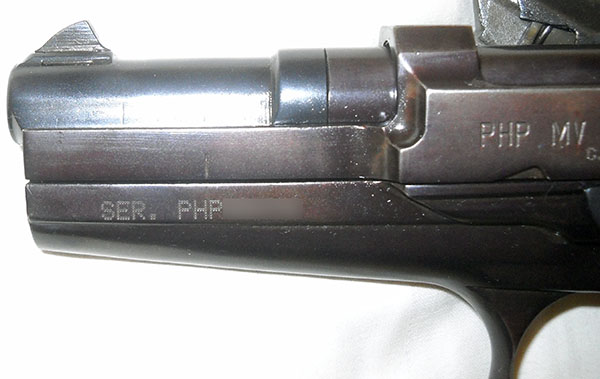
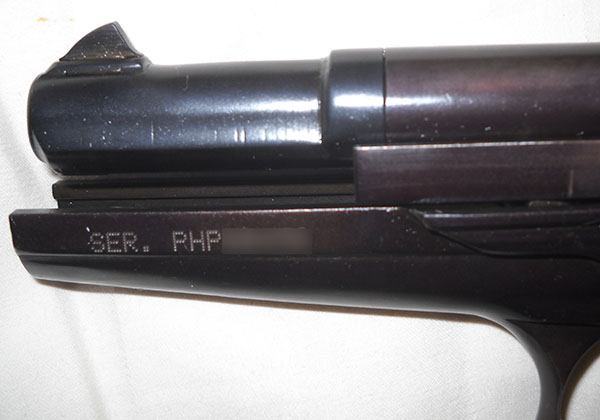
You may have noticed the "SER. PHP(blur)" marking on the side of the lower frame there. That's an importer's mark—remember how I mentioned a while ago that some imports seem to have been marked with a dot-matrix peening device? Here's one. (You can just make out in the wide shot of the left side that this one was a Century Arms import.) Weirdly, the importers didn't actually have to assign these guns new, completely-made-up serial numbers; that's only required if the gun's original manufacturer-assigned serial number doesn't start with a Roman letter or Arabic numeral (e.g., some Russian firearms' serial numbers start with Cyrillic letters), and this gun's original serial number, which is plainly marked on both the frame and the slide on the other side of the gun, is just a regular old five-digit number. Importers. Go figure.
Anyway, like the P38, the PHP has an exposed barrel, although unlike the P38, its frame extends all the way to the muzzle and the slide has those little "cheek" pieces on it. Not sure what purpose those serve, other than to set it apart visually from its parent. (There was also another version of the PHP, the VM17, with a longer barrel, so that the frame doesn't go all the way to the end. That looks more like a P-38, except the proportions are wrong.)
Another closed/open comparison view, this time from the top:

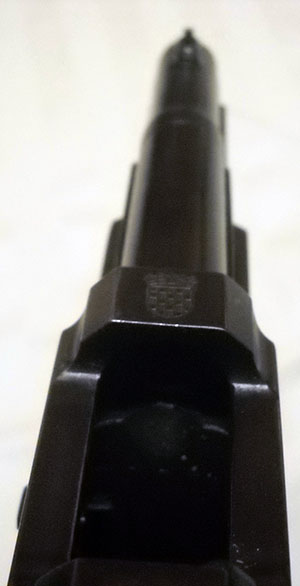
The PHP is another semiauto pistol, like the Nambu, that ejects out the top rather than through a side port. In a nicely nostalgic touch, the top of the slide is marked with the Croatian coat of arms.
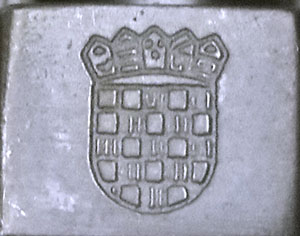
National crests on the tops of firearms used to be a traditional thing in Europe, but largely went out of fashion after World War II. It's interesting to me that, even in the midst of a rushed and desperate battle for national survival, the PHP's designer took the time to include a detail like that.
At any rate, the PHP is not a terribly well-designed or well-made gun (though to be fair, the guns its design is mostly stolen from are well-regarded), but it does have its good points. It served its purpose adequately, and though the manufacturing work is not of terrific quality, they don't seem to be particularly bad guns. Mine has an inoperative safety, but its actual functioning is fine. They're certainly not overcomplicated. They also have decent ergonomics. In spite of its chunky 15-round double-stack magazine, mine is comfortable to hold and shoot, partly because it has really-rather-nice wraparound plastic grips.
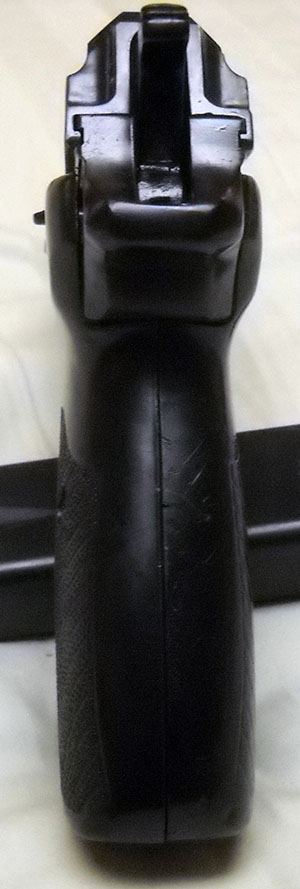
This shot also shows off one of the PHP's other unexpectedly nice features, which is that despite having been hurriedly manufactured in facilities that were rather less than cutting edge, the parts are surprisingly well-deburred. Look at the corners and edges up top there, around the hammer. Everything's nicely rounded and smoothed. You don't always get that in east-European handguns. Serbian Tokarev clones, for instance, have corners you could crease paper with.
Downsides notwithstanding, the PHP served its purpose, but once the war was over and Croatia could get on with cleaning up and establishing a proper independent economy, the nascent Croatian firearms industry moved on to more sophisticated endeavors. The PHP was withdrawn from service by the end of the decade and replaced with the polymer-framed HS2000, which I haven't handled, but which is well enough regarded that it's selling fairly well in the US as the Springfield Armory* XD.
--G.
* This is a private company and has nothing to do with the government's Springfield Armory, which manufactured weapons for the US armed forces from 1777 to 1968 and is now a museum.